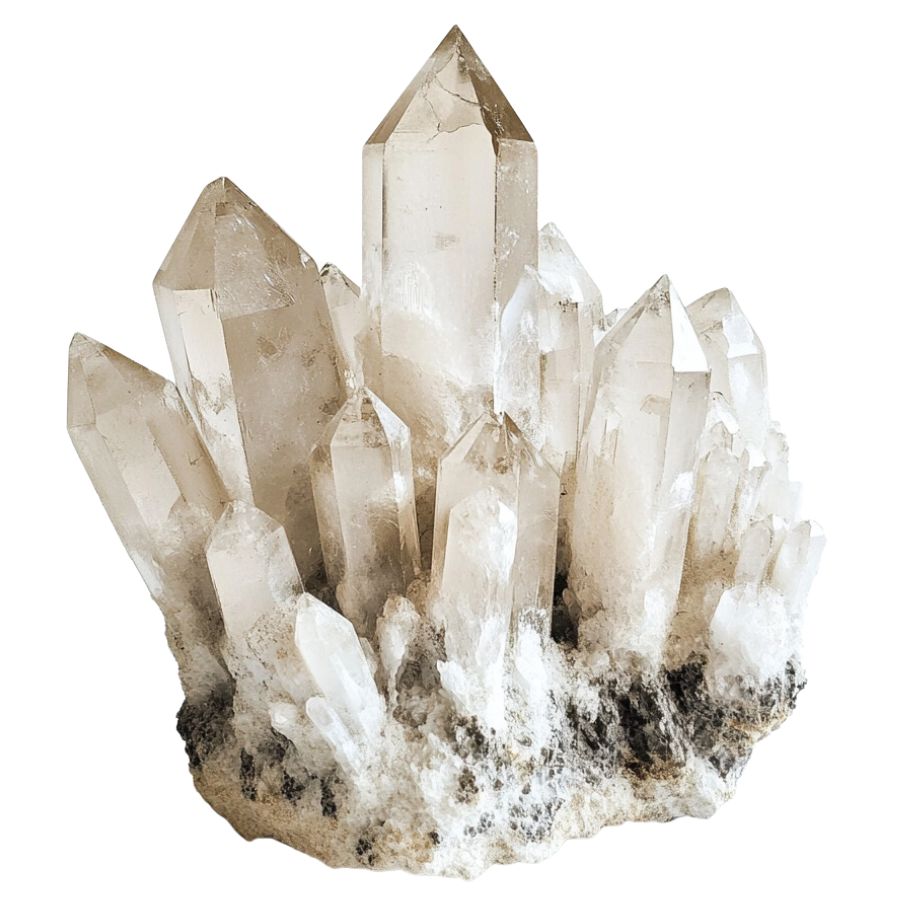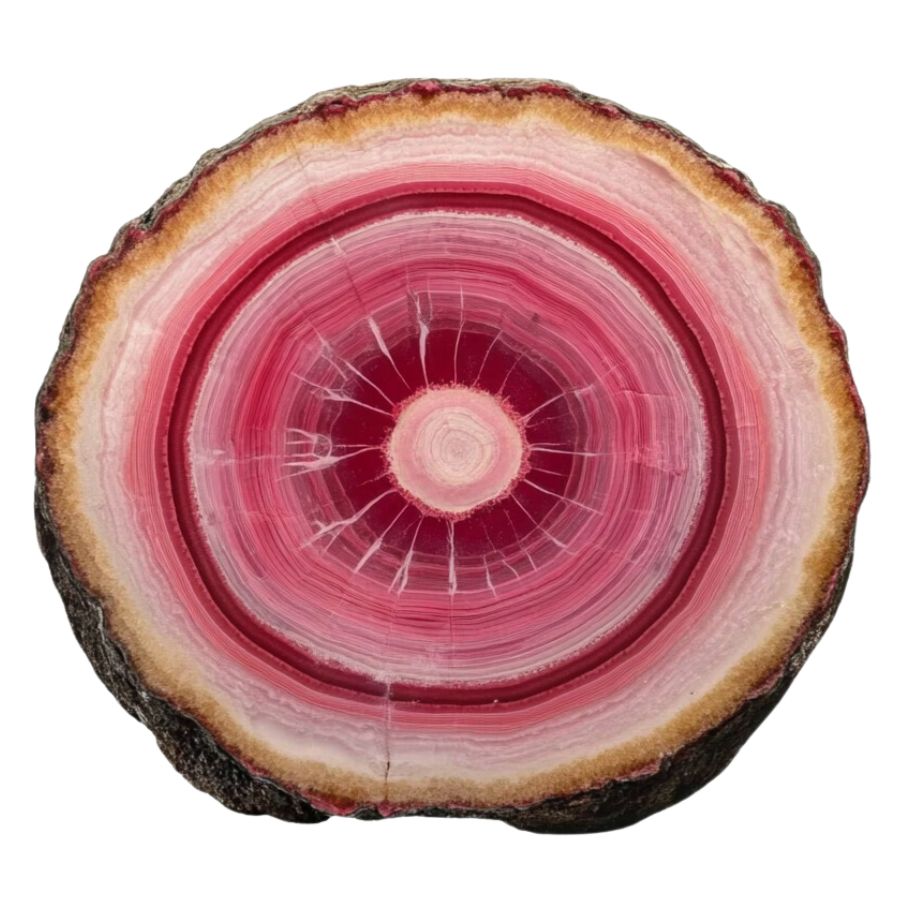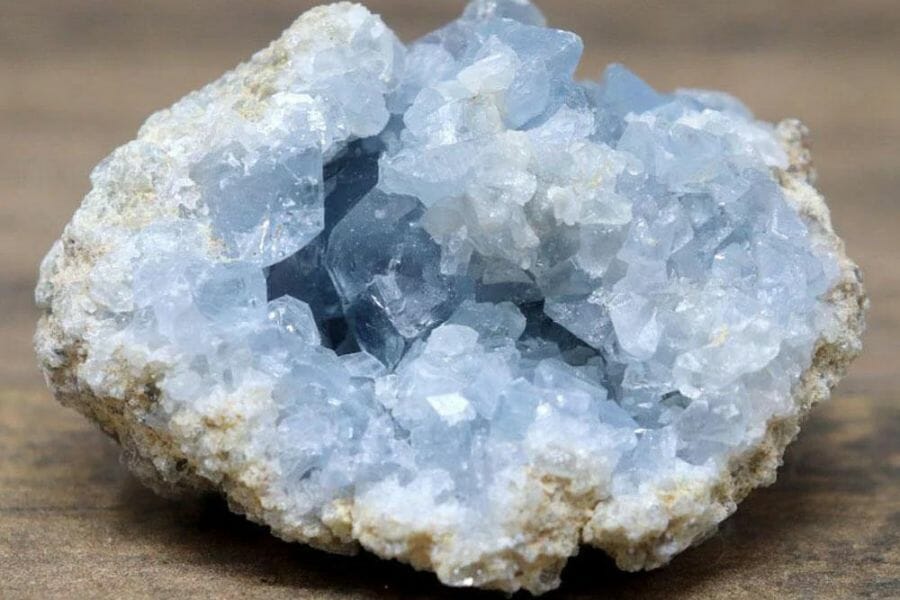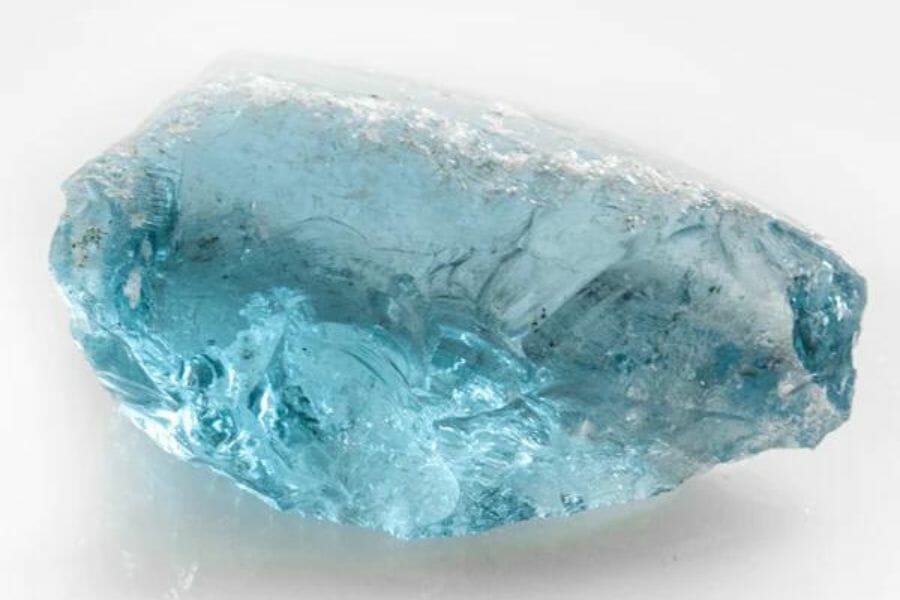Finding crystals can be a rewarding adventure, offering a unique way to explore the natural beauty and geology of the region. Whether you’re a seasoned rockhound or just getting started, knowing where to look is key to uncovering these hidden treasures.
In this state, a variety of locations provide opportunities to discover different types of crystals. From rocky outcrops in the mountains to stream beds that carry sparkling surprises, each area offers its own unique finds for those willing to search.
We can help you get started with some places you can explore for crystals below!
Crystals you can find in the US
The United States offers a wide range of crystals that reflect its diverse geology. From vibrant gems to more subtle mineral formations, there’s something to discover in nearly every region.
Calcite

With a variety of forms and a unique property of double refraction, calcite allows objects viewed through the crystal to appear doubled. This mineral can appear in a spectrum of colors, with pure forms typically being transparent or white.
In addition, calcite reacts vigorously with acids, which aids in distinguishing it from other minerals. It also frequently contributes to the structure of sedimentary rocks such as limestone.
Gypsum

Gypsum’s notable softness allows it to be easily scratched with just a fingernail, often presenting as white or very light-colored in its pure form.
It manifests in both crystalline forms, like selenite, and massive forms such as alabaster, making it versatile in use and appearance.
Gypsum is also essential in the construction industry and is a key component in the manufacture of plaster and drywall.
Fluorite

Fluorite comes in a wide range of vibrant colors, including purples, greens, blues, and yellows, and is known for forming in well-defined cubic crystals.
Beyond this, fluorite exhibits fluorescence under ultraviolet light! It can also be used in various industrial applications, including as a flux in steelmaking.
Galena

Galena distinguishes itself with a metallic luster and high density, typically found in a cube-like form. It serves as the primary ore of lead, making it important in the metal industry, while its shiny, silver color attracts collectors.
Not only does its appearance make it a subject of interest, but its weight and texture provide tangible lessons in mineral density and metallic properties. Galena also often contains traces of silver, adding to its commercial and educational value.
Corundum

Corundum is a mineral that comes in a variety of colors, though it is typically transparent or gray. Its most famous forms are sapphires and rubies, which are prized for their vibrant blue and red hues.
The mineral is known for its remarkable hardness, ranking just below diamond on the Mohs scale. This durability makes corundum ideal for industrial abrasives and cutting tools, as well as a popular choice for fine jewelry.
Quartz

Quartz is among the most common minerals in the Earth’s crust and is prized for its durability and variety. It forms in a wide range of colors and types, from clear rock crystal to purple amethyst.
The mineral is notable for its hardness and durability, which contribute to its use in a variety of applications. Quartz is also popular in the manufacturing of electronics and watches due to its piezoelectric properties, which allow it to convert mechanical pressure into electrical energy.
Pyrite

Often mistaken for gold due to its metallic luster and pale brass-yellow hue, pyrite is known colloquially as “fool’s gold.” Its characteristic cube-shaped crystal formations look man-made but are actually completely naturally formed!
Pyrite also has historical importance in producing sulfur dioxide for sulfuric acid production.
Rhodochrosite

Rhodochrosite stands out with its rich pink and red hues, making it highly desirable as both a mineral specimen and a gemstone.
It typically forms in layered or stalactitic structures, with bands of colors that showcase how it grew over millions of years.
Beyond its beauty, rhodochrosite is significant as the main source of manganese, an essential element used in metal alloys.
Rhodonite

Appreciated for its deep pinks and reds, often complemented by black manganese oxide veins, rhodonite presents a dramatic appearance. It is typically found in metamorphic rocks and is used both as an ornamental stone and in jewelry.
In geology, rhodonite is significant for its role in metamorphic processes and its association with other manganese-rich minerals. It can be found in metamorphosed sedimentary rocks and is sometimes used as an indicator of the presence of manganese deposits.
Vivianite

Vivianite, an iron phosphate mineral, emerges in low-oxygen environments like peat bogs or iron-rich deposits. Its striking blue to green color, which can change to a lighter shade over time due to oxidation, makes it a distinctive mineral.
Found in various geological settings, vivianite provides clues about the local conditions and the presence of phosphate deposits.
The Types of Texas Crystals You Can Find

Texas is home to a diverse range of crystals, each with unique color, shape, and properties. From the clear quartz crystals found in the Hill Country to the smoky quartz and amethyst of the Big Bend region, there are countless options for crystal hunters to explore. The beauty of these crystals is truly stunning and will captivate anyone who appreciates their natural wonder!
Rare crystals found in Texas
- Amazonite
- Amethyst
- Black Tourmaline
- Blue Topaz
- Carnelian
- Smoky Quartz
More common crystals found here
- Agate
- Calcite
- Celestite
- Chalcopyrite
- Epidote
- Fluorite
- Galena
- Jasper
- Muscovite
- Quartz
- Turquoise
What rough crystals look like
When you’re out looking for crystals on your own it’s important to know what you’re looking for. This is what you need to look out for:
Look for exteriors like this

When you’re out searching for crystals in the wild, it’s essential to keep in mind that what you find won’t look like the polished stones you see in stores. One important tip is to consider what certain crystals look like in their raw, natural form.
Without the shine and smooth finish, crystals might appear rough, with jagged edges or earthy tones masking their true beauty. Understanding this can help you spot potential finds that might otherwise be overlooked.
Examine the crystal structure and shape

Crystals often form in specific geometric patterns that can be key to identifying them. For example, quartz is known for its hexagonal prisms, while halite typically forms cubic shapes.
By recognizing these distinct patterns, you can differentiate between various types of crystals and better understand what you’ve found.
Observe color

Some crystals are known for their distinct hues, like the deep purple of amethyst or the vibrant green of emerald. However, not all crystals will have strong colors; some may be clear or only slightly tinted.
Check the luster

Luster refers to how a crystal’s surface interacts with light. Some crystals might have a shiny, glassy luster, while others may appear metallic or dull. This characteristic can help you determine the type of crystal you’ve found.
However, it’s important to remember that luster isn’t always obvious right away. In some cases, a crystal’s true luster will only become apparent after it’s been cleaned or polished, so keep this in mind as you examine your finds.
Evaluate the transparency

Pay close attention to how much light passes through the crystal. Some crystals are completely clear, allowing light to pass through easily, while others may be opaque and block light entirely.
You might also encounter crystals with translucent edges but opaque centers. These variations in transparency can offer valuable clues about the type of crystal you’ve found, making it easier to identify and appreciate your discovery.
A Quick Request About Collecting
Always Confirm Access and Collection Rules!
Before heading out to any of the locations on our list you need to confirm access requirements and collection rules for both public and private locations directly with the location. We haven’t personally verified every location and the access requirements and collection rules often change without notice.
Many of the locations we mention will not allow collecting but are still great places for those who love to find beautiful rocks and minerals in the wild without keeping them. We also can’t guarantee you will find anything in these locations since they are constantly changing.
Always get updated information directly from the source ahead of time to ensure responsible rockhounding. If you want even more current options it’s always a good idea to contact local rock and mineral clubs and groups
Tips on where to look
Having a better idea of where to look can greatly narrow down your search and increase your chances of finding crystals. By focusing on environments where crystals are likely to be exposed, you can spend less time searching and more time discovering.
Outcrops and Exposed Rock

Rocky outcrops are prime locations for finding crystals and minerals. Search along the edges of outcrops, particularly where erosion has worn away the surrounding soil, revealing the rock underneath.
Pay close attention to any visible cracks, crevices, or small cavities within the outcrop, as these are often where crystals develop and can be extracted with minimal effort.
Stream Beds and Gravel Deposits

Stream beds are dynamic environments where water flow constantly shapes the landscape. Over time, water can erode rocks upstream, breaking them down and carrying mineral fragments, including crystals, downstream.
When searching in these areas, look for spots where the current has slowed, such as bends in the stream or areas behind large rocks, as these are prime locations for deposits.
Quarries and Mines

Quarries and mines are excellent places to search for crystals because they expose deep layers of rock that would otherwise be hidden beneath the surface. These sites often contain a variety of minerals and crystals that have been brought to the surface during excavation.
Pay attention to tailings piles, where waste rock is discarded, as they often contain overlooked or broken crystals. Always prioritize safety when exploring these areas and ensure that you have permission to search.
Road Cuts and Construction Sites

As roads are cut through hillsides or construction projects dig deep foundations, layers of rock and soil that have been undisturbed for millions of years are suddenly exposed.
Look for freshly exposed rock faces, especially where blasting has occurred, as this can create fissures or expose pockets filled with crystals. Be cautious around active construction sites, and always seek permission before exploring.
Mountainous Areas

In mountainous regions, erosion caused by wind, rain, and ice can wear away the softer rock, exposing harder crystals that have formed within. Focus on weathered and broken rock formations.
Look for scree slopes, where loose rock has accumulated at the base of cliffs. Additionally, areas near fault lines or volcanic vents are particularly promising, as they often have a higher concentration of minerals.
Texas Crystal Mining Laws And Regulations
Although it’s allowed to mine crystals in Texas, it’s crucial to abide by all local, state, and federal rules, especially those from the Texas Commission on Environment Quality that control the crystal gathering on public lands.
This involves acquiring the appropriate permissions or permits from the landowner or administrative body in charge of the area you intend to mine. Rules and limitations might also be in place to safeguard the local ecology.
- The extensive local experience and understanding of our team
- Input from multiple local crystal hunters and crystal collecting groups
- The accessibility of the crystal mining locations
- Safety and potential hazards when collecting
- Private and public locations
- A desire to include locations for both experienced crystal hunters and those who are just starting out
Using these weights we think we’ve put together the best list out there for those who love finding new crystals for our collections!
The Best Locations For Crystal Mining in Texas

You should visit these areas if you only have time to travel to a few locations. These locations have provided the greatest success for us, and we believe you will too.
Always Confirm Access and Collection Rules!
Before heading out to any of the locations on our list you need to confirm access requirements and collection rules for both public and private locations directly with the location. We haven’t personally verified every location and the access requirements and collection rules often change without notice.
Many of the locations we mention will not allow collecting but are still great places for those who love to find beautiful rocks and minerals in the wild without keeping them. We also can’t guarantee you will find anything in these locations since they are constantly changing.
Always get updated information directly from the source ahead of time to ensure responsible rockhounding. If you want even more current options it’s always a good idea to contact local rock and mineral clubs and groups
The Bonanza Mine is Our Favorite Crystal Mine in Texas

El Paso County, TX 79851, United States
If you’re looking for a great spot to find some beautiful crystals in the state, you might want to check out the Bonanza Mine. This historic location has been a favorite of crystal hunters for many years, and it’s not hard to see why. This is also among the best locations to find gems in Texas.
The Bonanza mine is in the Big Bend region of Texas, near Marfa. The mine was first discovered in the 1920s and was actively mined for lead, zinc, and silver until the 1940s. However, it wasn’t until later that crystal hunters discovered the incredible variety of crystals that could be found at the site.
One of the great things about the Bonanza mine is that it’s accessible to beginners and experienced crystal hunters. The area is open to the public; no fees or permits are required to collect crystals. However, respecting the area and not damaging the rocks or surrounding environment is important.
Where we found crystals at the Bonanza Mine
The east side of the Bonanza Mine was where we got the best results while looking for chalcopyrite and galena crystals.
Brewster County

Brewster County is in the Big Bend region of Texas and is characterized by mountains, canyons, and deserts, making it a diverse and exciting place to explore. The region’s geology is just as varied, with a wide range of minerals and crystals found throughout the area. Crystal hunters can explore abandoned mines and search for crystals in vugs and other small pockets within the rock.
The history of Brewster County dates back to the mid-1800s when ranchers and miners first settled the region. Mining played a significant role in the area’s development, with silver, lead, and other minerals extracted from the earth. The region is still a popular spot for mining and crystal hunting, with many different types of crystals like ambers, agates, jaspers, quartz, and other minerals throughout the area.
Brewster County is a fantastic spot for anyone who loves rocks and minerals. With its rich history, stunning geography, and diverse geology, there’s always something new and exciting to discover. So, pack up your rock hammer and safety goggles and head to Brewster County for a crystal hunting adventure you’ll never forget.
Where we found crystals at Brewster County
There are a ton of excellent options available here. To get started, try the following areas:
- You may locate agates, jaspers, and quartz in the Glass Mountains area.
- A large area at Needle Peak in the Study Butte area contains agates.
- Amber, agates, and jaspers are available at the Terlingua Creek banks along the county’s western edge.
- Galena may be found in the Altuda area mines.
- Excellent galena specimens are found at the Solitario area mines,
- The area mines in Terlingua offer calcite and fluorite crystals.
You can check how much is crystal worth by visiting our guide.
Chinati Mountain

If you’re looking for a great spot to find and collect crystals, the Chinati Mountains should definitely be on your radar. This rugged region’s rich history and geology make it a fantastic spot for crystal hunting. The Chinati Mountains are located in the Trans-Pecos region of Texas, and these mountains are part of the Chihuahuan Desert, known for its unique flora and fauna. The area’s geology is equally fascinating, with a wide range of minerals and crystals throughout the region.
The Chinati Mountains’ history began in the middle of the nineteenth century when ranchers and miners began to occupy the region. Silver, lead, and other minerals were mined, and this activity contributed significantly to the region’s growth. The area is still well-liked today for mining and crystal hunting because of the wide variety of crystals.
The region surrounding the former Shafter Mine is one of the most popular locations for searching for crystals in the Chinati Mountains. Calcite, fluorite, and other minerals can be found in this area. The ancient mine can be explored by crystal hunters looking for crystals in other tiny rock crevices.
Ultimately, anyone who enjoys rock and minerals will love the Chinati Mountains. There is always something fresh and fascinating here because of its rich history, breathtaking geography, and diversified geology. So prepare a crystal hunting adventure you won’t soon forget!
Where we found crystals in the Chinati Mountains
We mostly found agate and jasper crystals at the regional draws, washes, and surfaces of the Chinati Mountains. There are also good specimens of fluorite and galena on the dumps of the area mines surrounding the Chinati Mountains along the southwest side of San Antonio Canyon.
Plata Verde Mine

Van Horn Mountains in Hudspeth County
The Plata Verde Mine should be at the top of your list if you’re seeking an excellent place to find and collect crystals! This historic site is perfect for crystal hunting because of its unique geology and history.
The Plata Verde Mine is located in the Big Bend region of the state. The mine was first discovered in the early 1900s and was actively mined for silver and other minerals until the 1940s. Today, it’s a popular spot for crystal hunters looking to add stunning specimens to their collections.
The geology of the Plata Verde Mine makes it such an incredible spot for crystal hunting. The area is rich in minerals, such as azurite, chrysocolla, malachite, muscovite, quartz, and turquoise, and these crystals are often found in small pockets or cavities within the rock. These can contain a variety of crystals, from small points to large clusters, making the mine an exciting place to explore.
Where we found crystals at the Plata Verde Mine
You may collect the minerals mentioned above at the Plata Verde Mine in the foothills of the northwest side of the Van Horn Mountains.
Quitman Mountains

Hudspeth County, TX 79851
The Quitman Mountains are a must-visit location for finding and collecting crystals. This stunning mountain range is located in the west-central part of the state and has a fascinating history and geology that make it a prime spot for crystal hunting.
The Quitman Mountains have a long and rich history, dating back to the mid-1800s when ranchers and miners first settled there. The mountains peak up to 8,000 feet above sea level. The area’s geology is just as diverse, with a wide range of minerals and crystals throughout the region.
What makes the Quitman Mountains such a great spot for crystal hunting is the variety of crystals that can be found in the area. Additionally, the crystals in the Quitman Mountains are often incredibly clear and have a unique beauty that’s hard to find anywhere else.
Where we found crystals at Quitman Mountains
We had the best luck finding agates, amethysts, carnelians, and jaspers along the south edge of the Quitman Mountains.
Our Other Favorite Places For Crystal Hunting

We wanted to provide you with many more options now that we’ve disclosed our five best locations for finding crystals. With a state the size of ours, particularly one with such geological diversity, there are many fantastic locations to search for crystals as well as Texas geodes. Here are some additional choices to consider:
Where you can find crystals for free in Texas
Let’s start by discussing some places that are free to search. While many of the greatest locations will require you to pay, some places are free for all.
| County | Location |
| Bastrop | You can find agates in breaks, cuts, and surfaces of Smithville |
| Brown | Numerous mined deposits at Zephyr for Celestite |
| Culberson | Prospects at the northeast side of the Carrizozo Mountains for turquoise |
| El Paso | Franklin Mountain road cuts for garnet and serpentine |
| Hudspeth | General area of the Van Horn Mountains for agate and jasper |
| Llano | County wide pegmatite exposures for topaz |
| Llano | West to Enchanted Rock for epidote and quartz |
| Mason | Pegmatite outcrops of the Gritt area for topaz |
| Webb | The Laredo Gravel Pit for agate and jasper |
| Webb | River bars on islands’ gravels and at low water for agates |
| Webb | All Rio Grande tributaries, stream bars, and stream beds for agates and jaspers |
Some of the more common crystals that are found here can be very easy to confuse, especially those that share many similarities. So to help you tell them apart, we’ve created a few guides you can use:
Other great places to dig for crystals
These are the additional locations to visit if you’re willing to spend a little money to find crystals. The season will determine how much they charge; occasionally, it may even be free, so contact them before going.
| County | Location |
| Burnet | Silver Creek area mines and prospects for galena |
| El Paso | The Sierra Diablo and other mines for chalcopyrite and galena |
| Hudspeth | Sierra Blanca area mines and prospects for turquoise |
| Live Oak | H.D. House Ranch for jasper |
| Llano | Barringer Hill area mines for fluorite |
| Llano | Kingsland area mines for fluorite |
| Llano | Charles Moss Ranch for epidote and quartz |
| Nolan | Sweetwater open pit mine for celestite |
| Presidio | Bishop Ranch for agates |
The Best Crystal Shops In Texas

Since the state has a large variety of crystals spread over such a vast area, many of us like making small purchases to complete our collections. If you’re seeking unique and stunning pieces for your collection, these are the top crystal shops we’ve located.
- Alamo City’s Rocks and Crystals – 1315 S Presa St, San Antonio, TX 78210, United States
- Auracle: World of Crystals – 1230 Westheimer Rd, Houston, TX 77006, United States
- Crystal Rock Shop – 2136 Roy Rd, Tyler, TX 75707, United States
- Crystal Source – 441 W Bedford Euless Rd, Hurst, TX 76053, United States
- Crystal Works – 908 W 12th St, Austin, TX 78703, United States
- Dance with Stones – 14761 Memorial Dr, Houston, TX 77079, United States
- Katy Rock Shop – 535 Pin Oak Rd, Katy, TX 77494, United States
- Nature’s Treasures – 4103 N Interstate Hwy 35, Austin, TX 78722, United States
- Power of the Rainbow – 1730 W Randol Mill Rd #125, Arlington, TX 76012, United States
- Rock Barrell – 13650 T I Blvd #104, Dallas, TX 75243, United States
Additional places to find crystals in nearby states
If you’ve already tried all of our recommendations above or are planning a trip out of the state, you should check out our guides for neighboring states:
If you have any recommendations we haven’t covered please leave them in the comments below!



